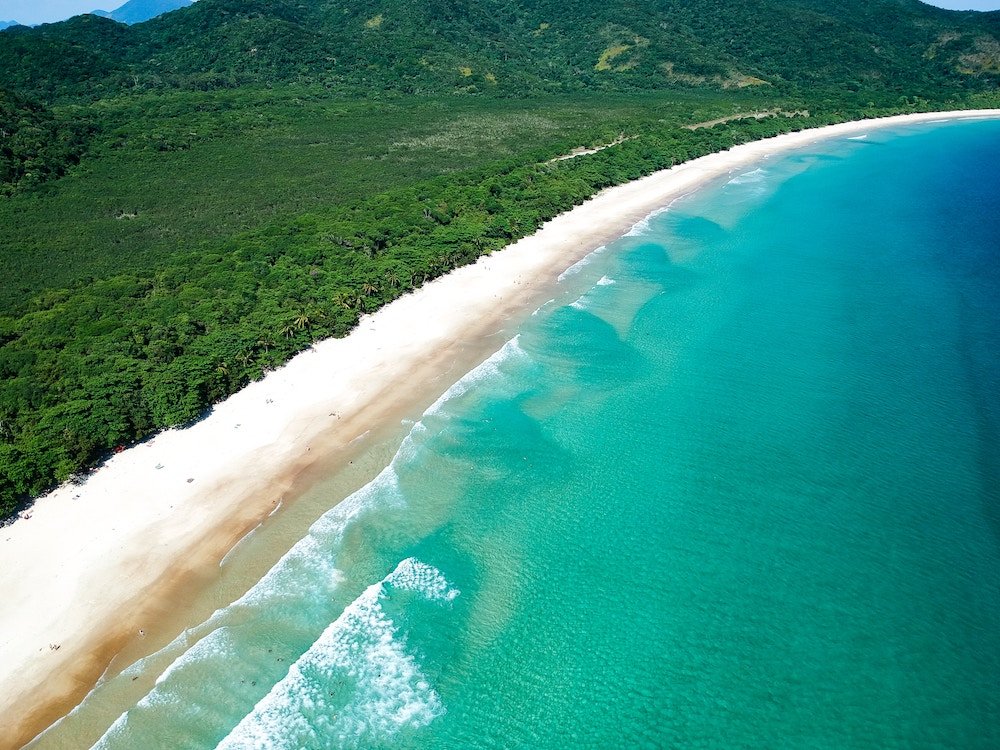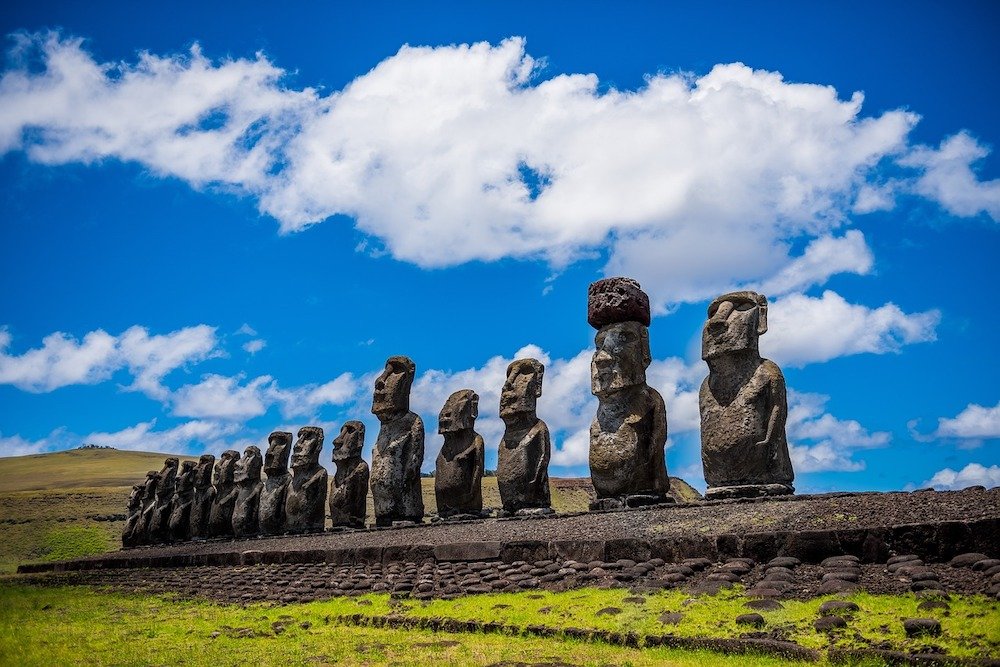
South American islands, with their breathtaking landscapes, rich biodiversity, and vibrant cultures, stand as captivating jewels in the vast expanse of the Southern Hemisphere.
From the mysterious Galápagos archipelago to the sun-kissed beaches of Ilhabela, each island offers a unique tapestry of experiences waiting to be unraveled.
The allure of these islands goes beyond mere geographical beauty; it encompasses a blend of history, ecology, and cultural richness.
As travelers seek destinations that provide an escape from the ordinary, South American islands emerge as the perfect canvases where nature and heritage coalesce.
Islands have always held a special place in the hearts of globetrotters.
They offer an intimate setting, often insulated from the hustle and bustle of mainland life.
South American islands, in particular, boast a magnetic appeal, drawing wanderers with promises of pristine beaches, vibrant marine life, and a sense of isolation that rejuvenates the soul.
The enchanting rhythm of life on these islands provides a unique escape, where time seems to slow down, and the natural wonders take center stage.
Whether it’s the biodiversity of the Galápagos or the ancient mysteries of Easter Island, these destinations become playgrounds for exploration and self-discovery.
Amidst the myriad of choices, selecting the perfect island destination can be a delightful yet challenging task.
This article aims to be your compass in the sea of possibilities, guiding you to the Top 12 South American Islands that beckon with their distinct charms.
We’ll uncover not only the beauty of each island but also practical insights to aid in your decision-making process.
1. Galápagos Islands
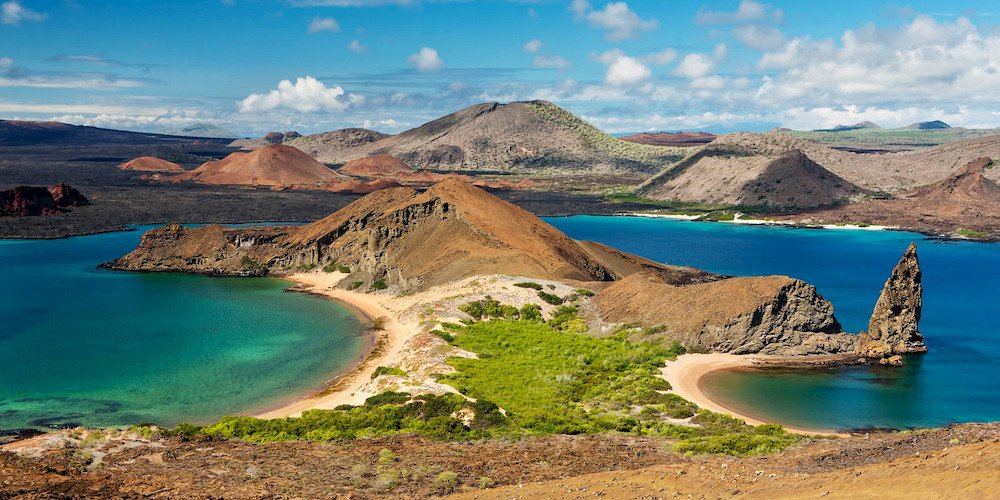
The Galápagos Islands, an archipelago in the Pacific Ocean, stand as a testament to the raw beauty of untouched nature.
This volcanic wonder, located off the coast of Ecuador, comprises 19 main islands and numerous islets.
Its isolated location has led to the evolution of unique and endemic species, making it a living laboratory for those curious about the wonders of life.
Unique Wildlife and Natural Attractions
One cannot speak of the Galápagos without marveling at its unparalleled wildlife.
Giant tortoises, marine iguanas, and blue-footed boobies roam freely, offering an up-close encounter with the extraordinary.
The archipelago’s marine life is equally captivating – snorkel alongside playful sea lions, glide with graceful sea turtles, and witness the dance of vibrant fish beneath the crystal-clear waters.
The landscapes are as diverse as the fauna, ranging from barren volcanic terrains to lush, green highlands.
Each island in the archipelago tells a unique story of adaptation and survival, creating an ecological mosaic that captivates and educates.
Activities and Adventures Available on the Islands
For those seeking more than just a passive appreciation of nature, the Galápagos Islands offer a plethora of activities.
Snorkeling in the coves, diving into underwater realms teeming with life, and hiking volcanic trails are just a few of the adventures awaiting intrepid explorers.
Embark on a cruise to traverse the archipelago, ensuring you don’t miss the distinct character of each island.
Naturalist-guided tours provide insights into the islands’ ecosystems, making every step a lesson in biodiversity.
2. Easter Island (Rapa Nui)
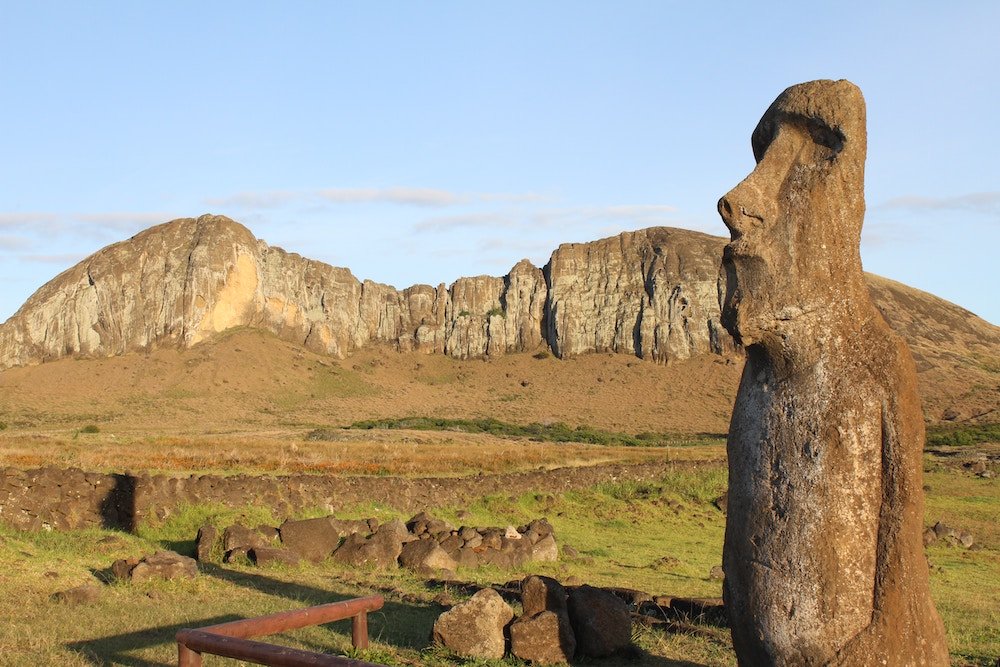
Easter Island, or Rapa Nui as it’s known to the locals, is a remote outpost in the southeastern Pacific Ocean, shrouded in enigma and surrounded by a vast expanse of ocean.
Its isolation adds an air of mystery to this UNESCO World Heritage site, capturing the imagination of travelers from around the globe.
The journey to Easter Island is not just a physical one; it’s a voyage into the depths of history and culture.
Iconic Moai Statues and Their Cultural Significance
Easter Island is perhaps best known for its iconic Moai statues, monumental stone figures that stand sentinel along the island’s coast.
These enigmatic giants, carved from compressed volcanic ash, are a testament to the artistic and engineering prowess of the Rapa Nui people.
Each Moai has a distinct personality, and their silent gaze imparts a sense of both awe and intrigue.
The cultural significance of the Moai extends beyond their impressive size.
They are believed to represent ancestors, with the statues strategically placed to watch over the villages.
Unraveling the mystery of how these colossal statues were carved, transported, and erected adds another layer of fascination to the island’s allure.
Beyond the stone guardians, Easter Island offers a wealth of cultural experiences for visitors.
Engage in traditional dance performances that convey the island’s stories and legends, or participate in workshops to create your miniature Moai as a unique souvenir.
Exploring the ceremonial village of Orongo provides insight into the island’s ancient rituals and beliefs.
Hiking to the volcanic craters and enjoying panoramic views of the Pacific Ocean adds a touch of adventure to the cultural immersion.
For those seeking a deeper connection, consider partaking in the Tapati Rapa Nui festival, an annual celebration of Rapa Nui culture featuring traditional competitions, music, and dance.
3. Fernando de Noronha, Brazil

Nestled off the northeast coast of Brazil, Fernando de Noronha emerges as a pristine archipelago that feels like a slice of paradise.
Designated a UNESCO World Heritage site, this Brazilian gem consists of 21 islands, each adorned with natural wonders that beckon travelers seeking unspoiled beauty and tranquility.
Pristine Beaches and Marine Life
Fernando de Noronha is renowned for its idyllic beaches with powdery white sands and crystalline turquoise waters.
Baía do Sancho, consistently voted one of the world’s best beaches, invites visitors to unwind in a secluded haven surrounded by towering cliffs.
Snorkeling and diving enthusiasts are treated to a vibrant underwater world, where coral reefs teem with colorful fish, sea turtles, and playful dolphins.
The island’s marine life is a testament to the importance of conservation efforts.
Schools of fish dance beneath the surface, and spinner dolphins perform acrobatic displays in the open ocean.
Every stroke of the water reveals a rich tapestry of biodiversity, making Fernando de Noronha a haven for nature lovers.
Environmental Conservation Efforts on the Islands
Preserving the delicate balance of Fernando de Noronha’s ecosystem is a top priority.
Stringent environmental conservation measures are in place to protect the archipelago’s unique flora and fauna.
Visitor numbers are controlled, ensuring that the islands remain a sanctuary for wildlife and a sustainable destination for years to come.
The local government and organizations work tirelessly to minimize the impact of tourism through waste management initiatives and strict regulations on activities that may harm the environment.
Educational programs engage both residents and visitors, fostering a sense of responsibility for the archipelago’s ecological well-being.
4. Tierra del Fuego, Argentina/Chile
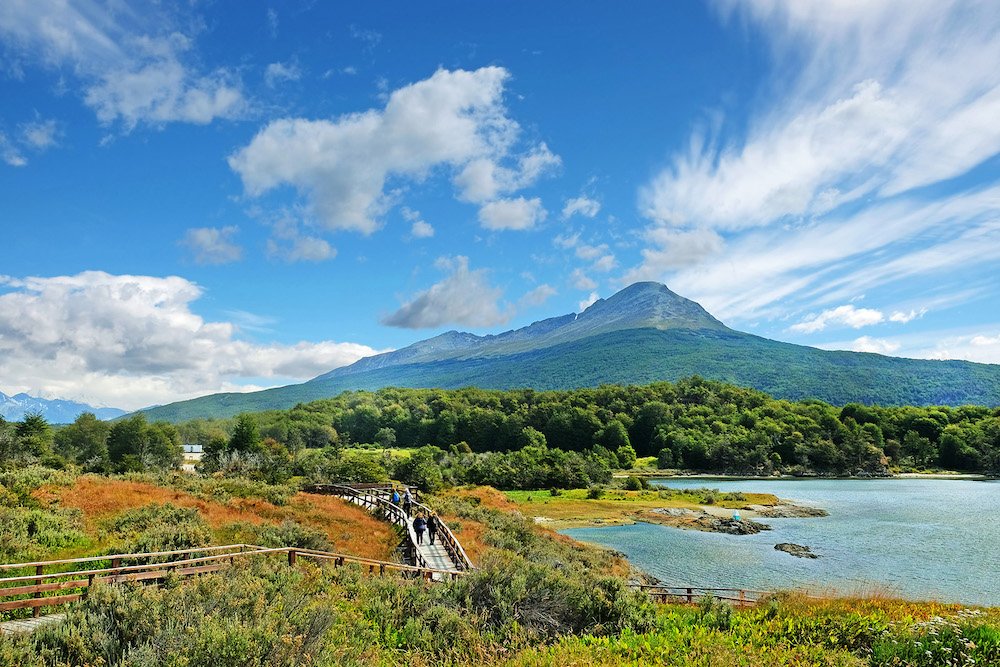
Tierra del Fuego, the “Land of Fire,” holds a mystical allure as the southernmost tip of South America, where the Andes mountain range meets the vast expanse of the Southern Ocean.
Shared by Argentina and Chile, this archipelago is a realm of rugged beauty and untamed wilderness, offering a unique adventure at the edge of the world.
Unique Landscapes and Wildlife
The landscapes of Tierra del Fuego are a dramatic fusion of mountains, glaciers, and fjords, adorned with windswept plains and ancient forests.
Be prepared to be awe-struck as you witness the iconic Beagle Channel, a passage navigated by Charles Darwin, framed by snow-capped peaks and icy waters.
The region is a haven for diverse wildlife. Magellanic penguins waddle along the shores, while sea lions bask on rocky outcrops.
Birdwatchers are treated to the sight of albatrosses gliding through the crisp air, and lucky observers may spot a pod of orcas or humpback whales navigating the chilly depths.
Outdoor Activities and Exploration Options
Tierra del Fuego beckons adventurers with a plethora of outdoor activities. Hiking trails weave through the landscape, providing vistas of unparalleled beauty.
The famed End of the World Train takes you on a journey through the region’s history, while boat excursions offer close encounters with marine life and access to remote islands.
For the more intrepid, embark on a trek to the Dientes de Navarino, the southernmost trekking circuit in the world.
Kayak through the Beagle Channel for a unique perspective of the rugged coastline, or try your hand at fly-fishing in the pristine rivers that cut through the wilderness.
5. Isla de la Plata, Ecuador

Known as the “Poor Man’s Galápagos,” Isla de la Plata off the coast of Ecuador is a hidden gem that mirrors the biodiversity and natural wonders of its famous counterpart.
Situated in Machalilla National Park, this island is a haven for wildlife enthusiasts seeking a more accessible alternative to the Galápagos Islands.
Birdwatching and Marine Life Experiences
Despite its nickname, Isla de la Plata is rich in flora and fauna.
The island is a sanctuary for birdwatchers, offering the chance to spot magnificent frigatebirds, blue-footed boobies, and albatrosses in their natural habitat.
The skies come alive with the fluttering of wings as diverse bird species call this island home.
Underwater, the marine life is equally captivating.
Snorkelers and divers are treated to encounters with manta rays, sea turtles, and a kaleidoscope of colorful fish.
The coral reefs surrounding the island add to the allure, creating an underwater paradise for those exploring the depths.
Accessibility and Travel Tips
Reaching Isla de la Plata is an adventure in itself.
Most visitors embark on a boat trip from the coastal town of Puerto López, providing an opportunity to enjoy the scenic journey across the Pacific.
It’s advisable to check weather conditions beforehand, as sea conditions can vary.
Guided tours are the best way to explore the island, with knowledgeable guides providing insights into the diverse ecosystems and wildlife.
Be sure to bring comfortable hiking shoes, swimwear, and a camera to capture the natural wonders.
For those prone to seasickness, consider taking motion sickness medication before the boat trip.
Additionally, check the island’s regulations regarding visitor impact, as conservation efforts are crucial to maintaining the ecological balance.
6. Ilha Grande, Brazil

Ilha Grande, a pristine paradise nestled near the coast of Rio de Janeiro, enchants visitors with its natural beauty and unspoiled landscapes.
Steeped in history and surrounded by crystal-clear waters, this Brazilian gem beckons travelers seeking a tranquil escape from the vibrant energy of Rio de Janeiro.
Beautiful Beaches and Hiking Trails
The allure of Ilha Grande lies in its diverse landscapes, where lush rainforests meet pristine beaches.
Lopes Mendes Beach, with its powdery white sand and turquoise waters, is a postcard-perfect haven for sun-seekers.
Adventurous souls can explore the island’s interior through well-maintained hiking trails, unveiling hidden waterfalls and panoramic viewpoints.
One of the island’s highlights is the Pico do Papagaio trail, leading to the summit for breathtaking views of the coastline and surrounding islands.
As you traverse the trails, the melodies of tropical birds and the rustling of palm leaves create a soundtrack to your exploration.
Eco-Friendly Initiatives on the Island
Ilha Grande is not just a natural marvel; it’s a testament to sustainable tourism practices.
The local community, recognizing the fragility of the island’s ecosystem, has embraced eco-friendly initiatives to preserve its pristine state.
Many accommodations on the island follow responsible tourism practices, minimizing their environmental impact.
The prohibition of motor vehicles on the island contributes to its peaceful ambiance and helps in maintaining air quality.
Waste management programs encourage visitors to minimize their ecological footprint, ensuring that the island remains a haven for generations to come.
Engage in eco-tours and volunteer programs to actively participate in the preservation efforts.
These initiatives not only allow visitors to give back to the community but also foster a deeper connection with the island’s natural wonders.
7. Archipelago Juan Fernández, Chile

Nestled in the Pacific Ocean, the Archipelago Juan Fernández is a secluded haven that holds the prestigious title of a UNESCO Biosphere Reserve.
This Chilean archipelago, comprising Robinson Crusoe Island and several smaller islets, captivates with its pristine landscapes and unique ecosystems, making it a destination for those seeking unspoiled natural beauty.
Robinson Crusoe Island and Its History
Robinson Crusoe Island, the largest in the archipelago, bears a name that hints at its intriguing history.
It served as the inspiration for Daniel Defoe’s classic novel and later became home to mariners, explorers, and castaways.
The island’s rugged terrain, marked by steep cliffs and lush valleys, tells a tale of resilience and survival.
The village of San Juan Bautista, the only settlement on Robinson Crusoe Island, provides a glimpse into the island’s history.
Visitors can explore sites such as Selkirk’s Lookout, named after Alexander Selkirk, the real-life inspiration for Robinson Crusoe.
The historical richness of the island is a testament to the human connection with this remote outpost.
Biodiversity and Conservation Efforts
Beyond its historical significance, the Archipelago Juan Fernández boasts extraordinary biodiversity, making it a haven for endemic species found nowhere else on Earth.
The Juan Fernández Fur Seal and the critically endangered Juan Fernández Firecrown hummingbird are among the unique inhabitants that contribute to the archipelago’s ecological importance.
Conservation efforts are paramount to protect this fragile ecosystem.
The Chilean government and environmental organizations work tirelessly to preserve the archipelago’s biodiversity.
Strict regulations control human activities on the islands, and ongoing research contributes to a deeper understanding of the unique flora and fauna, aiding in conservation strategies.
8. Isla Margarita, Venezuela
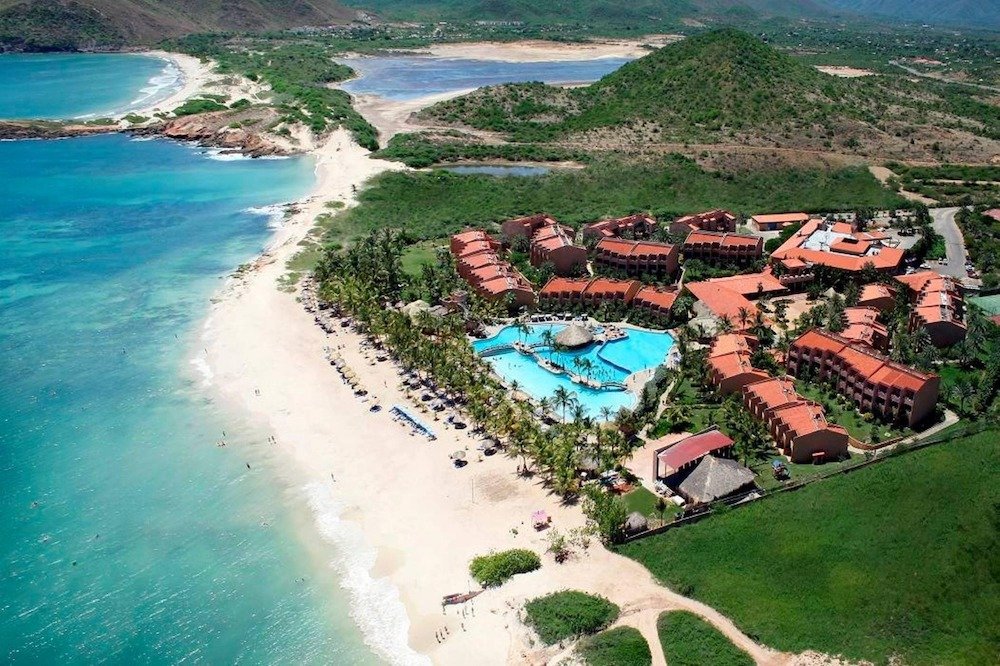
Nestled in the Caribbean Sea, Isla Margarita stands as a Venezuelan jewel, inviting travelers to bask in its sun-kissed splendor and vibrant culture.
Known as the “Pearl of the Caribbean,” this island paradise boasts pristine beaches, azure waters, and a rich tapestry of traditions that make it a sought-after destination.
Beach Resorts and Cultural Attractions
Isla Margarita is synonymous with relaxation, and its beach resorts epitomize the epitome of Caribbean luxury.
From Playa El Agua’s expansive shores to the secluded coves of Playa Caribe, the island offers a variety of beachfront retreats.
These resorts not only provide a haven for sun-seekers but also serve as gateways to the island’s cultural attractions.
Explore the historic La Asunción, the island’s capital, where colonial architecture and vibrant markets create a charming ambiance.
The Castillo de Santa Rosa, a fortress with a rich history, stands as a testament to the island’s strategic importance throughout the centuries.
Dive into the local markets to experience the vibrant colors and flavors of Venezuelan culture.
Safety Tips for Travelers
While Isla Margarita is a tropical paradise, ensuring a safe and enjoyable visit is paramount.
Here are some safety tips for travelers:
- Currency and Cash: Ensure you have local currency (Bolívar) for small transactions, and use reputable ATMs when needed.
- Personal Belongings: Keep your belongings secure, especially in crowded areas and on public transportation.
- Health Precautions: Stay hydrated, use sunscreen, and take necessary health precautions. Check if any vaccinations are required before traveling.
- Local Customs: Familiarize yourself with local customs and etiquette to show respect to the island’s residents.
- Language: While Spanish is the official language, English is often spoken in tourist areas. Learning a few basic Spanish phrases can enhance your experience.
- Weather Awareness: Stay informed about weather conditions, especially during hurricane season. Follow local advice in case of adverse weather.
By embracing these safety tips, you can fully immerse yourself in the beauty and warmth of Isla Margarita.
9. Chiloé Archipelago, Chile
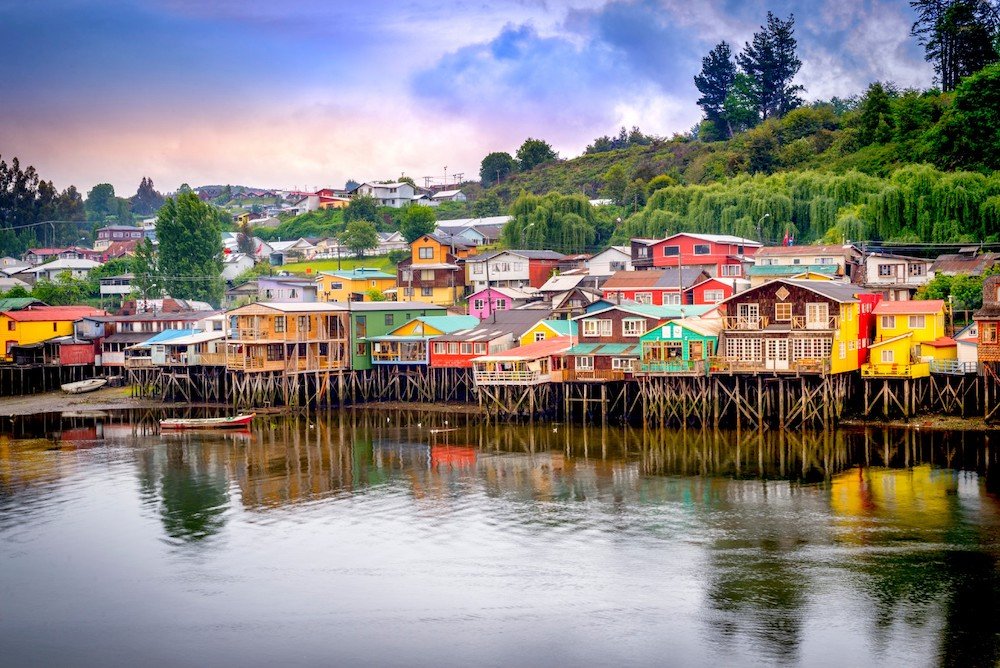
The Chiloé Archipelago, a cluster of islands off the coast of southern Chile, holds a cultural richness and natural beauty that sets it apart.
At the heart of this archipelago lies the largest island, Chiloé.
With its mist-shrouded landscapes and captivating folklore, Chiloé beckons travelers to discover its unique charm.
Unique Architecture and Cultural Traditions
Chiloé is synonymous with distinctive architecture that reflects the island’s cultural heritage.
Iconic wooden churches, declared UNESCO World Heritage sites, stand as testament to the blending of Spanish and indigenous Chono influences.
These intricately crafted structures, with their shingled facades and colorful details, dot the island, creating a picturesque backdrop against the lush greenery.
Beyond architecture, Chiloé is steeped in unique cultural traditions.
The island’s mythology includes tales of mythical creatures like the Trauco and the Caleuche, adding an air of enchantment to the local folklore.
Traditional festivals, such as La Minga and the Festival Costumbrista, showcase Chiloé’s vibrant traditions, inviting visitors to partake in the island’s rich cultural tapestry.
Culinary Delights and Local Specialties
Chiloé’s culinary scene is a delightful fusion of fresh seafood and traditional recipes, offering a unique gastronomic experience.
From curanto, a traditional Chilote feast cooked underground with layers of meat, potatoes, and shellfish, to milcao, a savory potato pancake, the island’s cuisine is a celebration of local ingredients and cultural history.
The Chiloé Archipelago is also renowned for its seafood, with iconic dishes like the renowned “chupe de jaibas” (crab stew) and “empanadas de mariscos” (seafood empanadas) tempting the taste buds of visitors.
The island’s commitment to sustainable and organic farming contributes to the authenticity of its flavors.
10. Isla del Sol, Bolivia
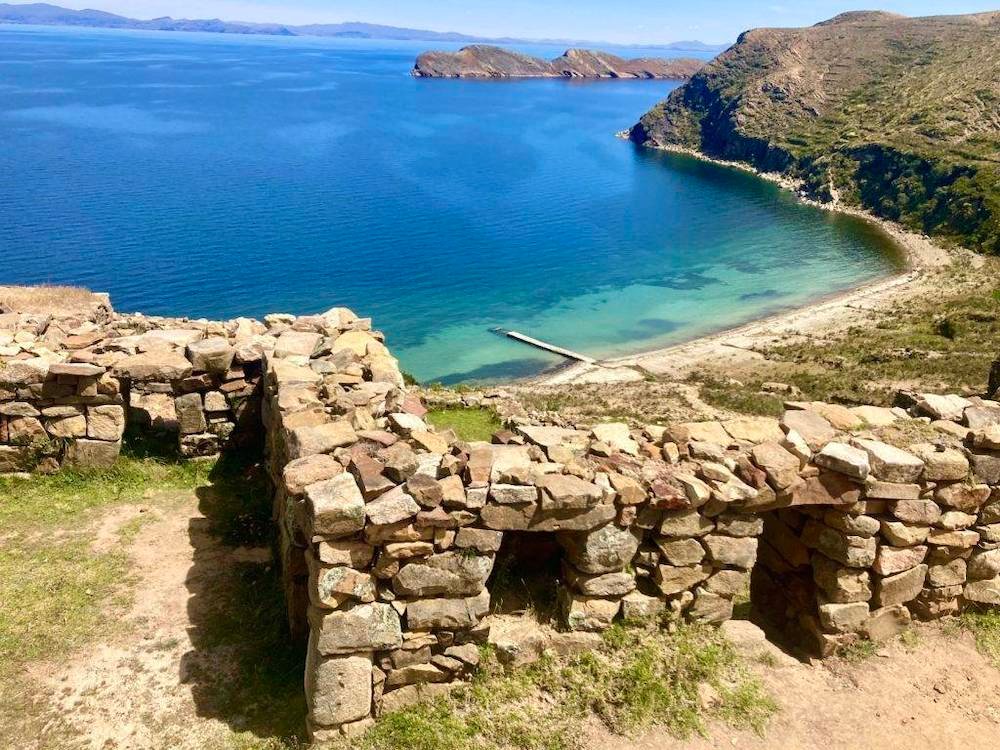
Nestled on the azure waters of Lake Titicaca, Isla del Sol emerges as a sacred gem, shrouded in Inca mythology and surrounded by the majestic Andes.
This island, revered by the Inca civilization, is a testament to the spiritual and cultural significance that permeates its landscapes.
Inca Ruins and Cultural Significance
Isla del Sol is a living archaeological treasure, adorned with remnants of Inca civilization that echo through the ages.
The island is home to the legendary “Rock of the Puma,” believed to be the birthplace of the Inca sun god Inti.
The Chincana ruins, an intricate labyrinth of stone structures, further contribute to the island’s mystique.
Pilgrims and travelers alike explore the sacred “Staircase of the Incas,” a stone path leading to the revered Fountain of Youth.
Each step on this ancient staircase seems to whisper tales of the Inca Empire’s spiritual connection to Lake Titicaca.
The island’s cultural significance extends beyond its archaeological wonders.
Indigenous communities on Isla del Sol maintain age-old traditions, allowing visitors a glimpse into their way of life.
Participate in local rituals, savor traditional cuisine, and immerse yourself in the rich folklore that weaves through the fabric of the island.
Boat Trips and Trekking Options
Exploring Isla del Sol is an adventure that unfolds on both land and water.
Boat trips across the azure expanse of Lake Titicaca provide stunning panoramic views of the island’s rugged contours.
As you approach the shores, the ancient terraces and structures come into view, creating a sense of anticipation for the historical wonders that await.
Trekking enthusiasts can embark on trails that crisscross the island, offering a closer encounter with its natural beauty.
The North and South routes provide varying landscapes, from gentle hills to rocky cliffs, all while showcasing the island’s diverse flora and fauna.
Each step allows you to absorb the serenity and spirituality that permeate the air.
11. Roatán, Honduras
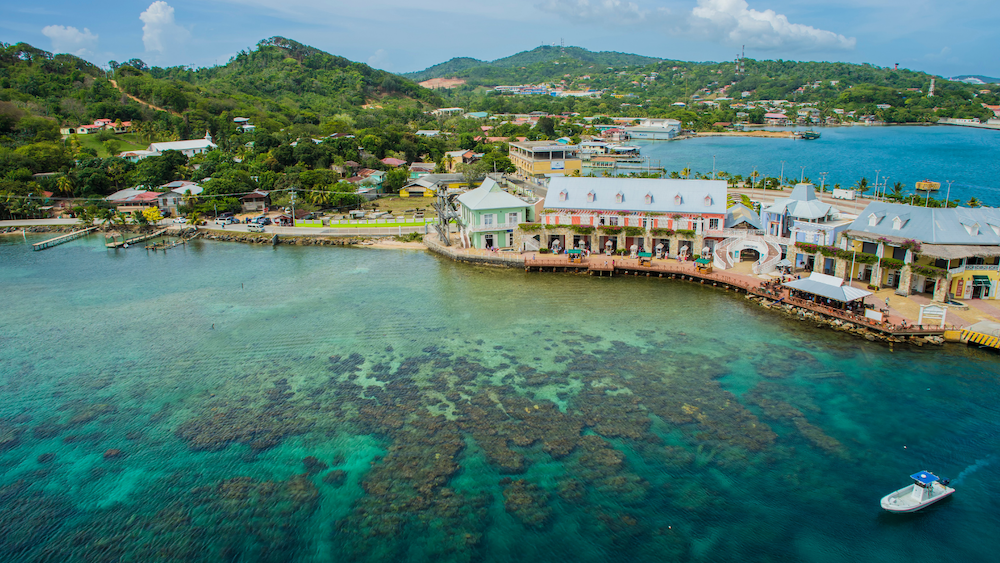
Nestled in the heart of the Caribbean, Roatán is a tropical paradise that captivates with its turquoise waters, white-sand beaches, and lush landscapes.
The largest of the Bay Islands, off the coast of Honduras, Roatán emerges as a haven for beach enthusiasts, adventure seekers, and those craving a laid-back island escape.
Coral Reefs and Diving Opportunities
Roatán’s underwater world is a mesmerizing tapestry of vibrant coral reefs and marine life, making it a premier destination for divers and snorkelers.
The Mesoamerican Barrier Reef, the second-largest coral reef system in the world, fringes the island, offering unparalleled opportunities for exploration.
Dive into the crystalline waters to discover a kaleidoscope of marine wonders.
From technicolor coral formations to schools of tropical fish, the reef’s biodiversity is a visual feast.
Encounter majestic sea turtles, playful dolphins, and even the elusive whale shark, creating a diving experience that is both thrilling and awe-inspiring.
Resorts and Amenities for Tourists
Roatán caters to visitors with a diverse array of resorts and amenities that blend seamlessly with the island’s natural beauty.
Whether you seek a luxurious beachfront retreat or a cozy eco-lodge, Roatán offers accommodations that cater to every taste and budget.
Resorts on the island provide not only comfortable lodgings but also a myriad of amenities to enhance your stay.
Enjoy spa treatments that harness the healing powers of the Caribbean, dine on exquisite seafood cuisine, and savor tropical cocktails while watching the sun dip below the horizon.
For the adventurous, the island offers a range of activities, from zip-lining through the lush canopy to exploring the island’s interior on horseback.
Snorkeling and diving excursions are readily available, allowing you to experience the magic of Roatán’s underwater realm.
12. Ilhabela, Brazil

Ilhabela, translated as the “Beautiful Island,” stands as a coastal gem off the shores of São Paulo, Brazil.
This idyllic destination, known for its natural beauty and vibrant culture, invites travelers to explore its pristine beaches, lush landscapes, and dynamic outdoor activities.
Pristine Beaches and Tropical Rainforest
Ilhabela lives up to its name with a coastline adorned by some of the most pristine beaches in Brazil.
From the soft sands of Curral Beach to the secluded beauty of Castelhanos Beach, each stretch of shoreline offers a unique setting for relaxation and water activities.
The clear waters of Ilhabela are ideal for swimming, snorkeling, and basking in the tropical sun.
Venture beyond the beaches, and you’ll find yourself immersed in a tropical rainforest paradise.
The Atlantic Forest that blankets the island provides a haven for biodiversity, with vibrant flora and fauna creating a picturesque backdrop for nature lovers.
Hiking trails crisscross the interior, leading to breathtaking viewpoints and hidden waterfalls.
Sailing, Water Sports, and Nature Trails for Visitors
Ilhabela is renowned as a sailing mecca, attracting enthusiasts from around the world.
The island hosts major sailing events, and its well-equipped marinas cater to sailors of all levels.
Whether you’re a seasoned sailor or a novice looking to try your hand at sailing, the azure waters surrounding Ilhabela offer the perfect playground.
Water sports enthusiasts will find a paradise of opportunities. Windsurfing, kiteboarding, and paddleboarding are just a few of the activities that thrive in the island’s favorable conditions.
The diverse marine life beneath the surface makes snorkeling and scuba diving experiences truly unforgettable.
For those seeking a more grounded adventure, nature trails crisscross the island, offering a chance to explore the lush landscapes on foot.
The trek to the summit of Baepi Peak rewards hikers with panoramic views of the island and the surrounding ocean.
Ilhabela, with its harmonious blend of sun-drenched beaches, vibrant rainforests, and a myriad of activities, invites visitors to discover the beauty that earned it the title of the “Beautiful Island.”
Conclusion
Our journey through the top 12 South American islands has taken us on a captivating exploration of diverse landscapes, rich cultures, and unique experiences.
From the iconic Galápagos Islands to the cultural tapestry of Chiloé Archipelago, each island has unfolded its own story, inviting us to immerse ourselves in the beauty of South America’s maritime jewels.
As we reflect on the allure of these islands, we encourage you to embark on your own adventure.
South America’s islands offer a kaleidoscope of experiences – from the pristine beaches of Ilha Grande to the mystical ruins of Isla del Sol.
Whether you’re drawn to cultural richness, underwater wonders, or simply the serenity of a tropical paradise, there’s an island that awaits your discovery.

FAQ’s About South American Islands
What Major Islands or Island Groups Are in South America?
- Galápagos Islands: Located off the coast of Ecuador, the Galápagos Islands are famous for their unique and diverse ecosystems, contributing significantly to Charles Darwin’s theory of evolution.
- Fernando de Noronha: A Brazilian archipelago known for its pristine beaches, vibrant marine life, and environmental conservation efforts.
- Tierra del Fuego: While not a single island but an archipelago, Tierra del Fuego is significant and located at the southernmost tip of South America, shared by Argentina and Chile.
- Chiloé Archipelago: Situated off the coast of Chile, this archipelago is known for its wooden churches, folklore, and lush landscapes.
- Ilhabela: Translated as the “Beautiful Island,” Ilhabela is off the coast of São Paulo, Brazil, known for its tropical beauty and water activities.
What Are Two Examples of Islands off the Coast of South America?
- Easter Island (Rapa Nui): Located in the southeastern Pacific Ocean, Easter Island is part of Chile and is famous for its monumental Moai statues.
- Roatán: A Caribbean island off the northern coast of Honduras, renowned for its coral reefs and water-based activities.
What Islands Are Between North and South America?
The islands between North and South America are collectively known as the Caribbean Islands or the West Indies.
This archipelago comprises numerous islands, including the Greater Antilles (Cuba, Jamaica, Hispaniola, and Puerto Rico) and the Lesser Antilles.
What Is the Island in South America That Starts with F?
The island in South America that starts with an F is Fernando de Noronha.
It is an archipelago off the northeast coast of Brazil, known for its environmental conservation efforts and stunning natural beauty.
